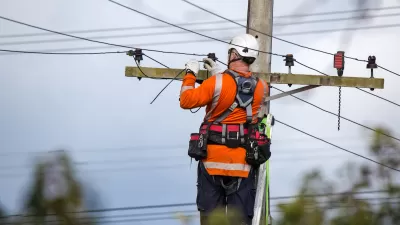How preparation and modern infrastructure can prevent power failures in an era of climate change.

The contrasting experiences of Texas and California during recent extreme weather events highlight the critical importance of resilient energy infrastructure and strategic planning in the face of climate change. For Yale Climate Connections, Dana Nuccitelli examines how Texas’ lack of preparation during Winter Storm Uri in February 2021 led to catastrophic power outages, while California’s proactive measures helped the state avoid major blackouts during record-breaking heat waves.
In Texas, over 4.5 million homes lost power during the storm, resulting in hundreds of deaths and revealing significant vulnerabilities in the state’s energy grid. Despite initial claims by Texas Gov. Greg Abbott that renewable energy was to blame, investigations showed that failures occurred across all types of power generation, including natural gas, coal, and wind. The primary issue was a lack of winterization and preparation for severe cold, not the inherent reliability of any particular energy source.
In contrast, California faced its own challenges during a record heatwave in 2020, which led to brief rolling blackouts. However, in the years following, the state made significant investments in grid management, battery storage, and regional cooperation. These efforts paid off during the extreme heat of 2024, when California's grid not only avoided blackouts but also provided energy to neighboring states.
For urban planners, these examples underscore the importance of investing in resilient infrastructure and adopting a comprehensive approach to energy management. Texas’ decision to maintain an isolated grid system further limited its ability to import power during the crisis, highlighting the risks of grid isolation and the benefits of regional integration.
FULL STORY: How mismanagement, not wind and solar energy, causes blackouts

Planetizen Federal Action Tracker
A weekly monitor of how Trump’s orders and actions are impacting planners and planning in America.

Canada vs. Kamala: Whose Liberal Housing Platform Comes Out on Top?
As Canada votes for a new Prime Minister, what can America learn from the leading liberal candidate of its neighbor to the north?

The Five Most-Changed American Cities
A ranking of population change, home values, and jobs highlights the nation’s most dynamic and most stagnant regions.

San Diego Adopts First Mobility Master Plan
The plan provides a comprehensive framework for making San Diego’s transportation network more multimodal, accessible, and sustainable.

Housing, Supportive Service Providers Brace for Federal Cuts
Organizations that provide housing assistance are tightening their purse strings and making plans for maintaining operations if federal funding dries up.

Op-Ed: Why an Effective Passenger Rail Network Needs Government Involvement
An outdated rail network that privileges freight won’t be fixed by privatizing Amtrak.
Urban Design for Planners 1: Software Tools
This six-course series explores essential urban design concepts using open source software and equips planners with the tools they need to participate fully in the urban design process.
Planning for Universal Design
Learn the tools for implementing Universal Design in planning regulations.
New York City School Construction Authority
Village of Glen Ellyn
Central Transportation Planning Staff/Boston Region MPO
Institute for Housing and Urban Development Studies (IHS)
City of Grandview
Harvard GSD Executive Education
Regional Transportation Commission of Southern Nevada
Toledo-Lucas County Plan Commissions




























